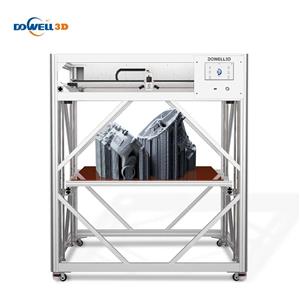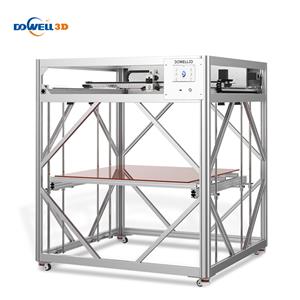Ten advantages of 3D printing for Dowell 3D FDM printer
The advantages of 3D printing traditional manufacturing can not match
Advantage 1: Manufacturing complex items does not increase the cost
As far as traditional manufacturing is concerned, the more complex the shape of the object, the higher the manufacturing cost. For 3D printers, the cost of manufacturing objects with complex shapes does not increase, and manufacturing a gorgeous object with complex shapes does not consume more time, skill or cost than printing a simple square. Manufacturing complex items without increasing costs will break the traditional pricing model and change the way we calculate manufacturing costs.
Advantage 2: Product diversification does not increase costs
A 3D printer can print many shapes, and it can make objects of different shapes every time like a craftsman. Traditional manufacturing equipment has fewer functions and limited types of shapes. 3D printing saves the cost of training mechanics or purchasing new equipment. A 3D printer only needs different digital design blueprints and a batch of new raw materials.
Advantage 3: No assembly required
3D printing can make the parts integrally formed. Traditional mass production is based on assembly lines. In modern factories, machines produce the same parts, which are then assembled by robots or workers (even across continents). The more parts of a product, the more time and cost it takes to assemble. The 3D printer can print a door and the matching hinge on it at the same time through layered manufacturing, without assembly. Omitting assembly shortens the supply chain and saves labor and transportation costs. The shorter the supply chain, the less pollution.
Advantage 4: Zero-time delivery
The 3D printer can print on demand. Instant production reduces the company’s physical inventory, and companies can use 3D printers to create special or customized products to meet customer needs based on customer orders, so new business models will become possible. If the goods people need are produced nearby on demand, zero-time delivery production can minimize the cost of long-distance transportation.
Advantage 5: unlimited design space
Traditional manufacturing techniques and craftsmen have limited product shapes, and the ability to make shapes is limited by the tools used. For example, traditional wooden lathes can only produce round objects, rolling mills can only process parts assembled with milling cutters, and mold making machines can only produce molded shapes. 3D printers can break through these limitations, open up a huge design space, and even make shapes that may currently only exist in nature.
Ten advantages and five challenges of 3D printing
Advantage 6: Zero-skill manufacturing
Traditional craftsmen need to be apprentices for several years to master the required skills. Mass production and computer-controlled manufacturing machines reduce the requirements for skills, but traditional manufacturing machines still require skilled professionals for machine adjustment and calibration. 3D printers obtain various instructions from the design documents to make the same complex items. 3D printers require less operating skills than injection molding machines. Unskilled manufacturing has opened up new business models and can provide people with new production methods in remote environments or extreme situations.
Advantage 7: It does not take up space and is portable manufacturing
In terms of unit production space, compared with traditional manufacturing machines, 3D printers have stronger manufacturing capabilities. For example, an injection molding machine can only manufacture objects much smaller than itself. In contrast, a 3D printer can manufacture objects as large as its printing table. After the 3D printer is debugged, the printing equipment can move freely, and the printer can make objects larger than itself. The high production capacity per unit space makes 3D printers suitable for home or office use because they require less physical space.
Advantage 8: Reduce waste by-products
Compared with traditional metal manufacturing technology, 3D printers produce fewer by-products when manufacturing metal. The waste of traditional metal processing is staggering. 90% of the metal raw materials are discarded in the factory floor. 3D printing reduces the amount of waste when manufacturing metal. With the advancement of printing materials, "net shaping" manufacturing may become a more environmentally friendly processing method.
Advantage 9: unlimited combinations of materials
For today's manufacturing machines, it is difficult to combine different raw materials into a single product, because traditional manufacturing machines cannot easily integrate multiple raw materials during the cutting or mold forming process. With the development of multi-material 3D printing technology, we have the ability to blend different raw materials together. Raw materials that could not be mixed before will form new materials. These materials have a wide variety of colors and unique properties or functions.
Advantage 10: accurate physical replication
Digital music files can be copied endlessly, and the audio quality will not decrease. In the future, 3D printing will extend digital precision to the physical world. Scanning technology and 3D printing technology will jointly improve the resolution of the form conversion between the physical world and the digital world. We can scan, edit and copy physical objects, create accurate copies or optimize the original.
Some of the above advantages have been confirmed, and others will become reality in the next ten or twenty years (or thirty years). 3D printing breaks through the familiar long-standing traditional manufacturing limitations, and provides a stage for future innovation.





